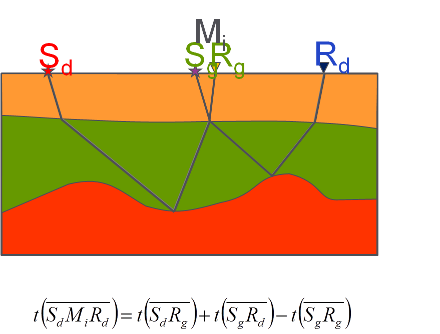Contact
DMT Petrologic GmbH & Co. KG
Karl-Wiechert-Allee 76
30625 Hannover, Germany
Phone: +49 511 5413917
E-Mail: info dmtpetrologic.com
dmtpetrologic.com
We can offer a broad set of multiple elimination tools to remove multiples from your data. We can handle any kind of complexity due to our advanced demultiple algorithms and implementations.
3D Interbed Multiple Elimination (IME)
Our proprietary implementation offers interbed demultiple for any input geometry and geological complexity. Our fast GPU and CPU implementation assures quick turn-around times while delivering high-fidelity multiple models in a data driven way. The idea behind the algorithm is that an interbed multiple can be expressed by a combination of three primaries. As these three primaries aren't necessary be recorded at the exact location required, interpolation is needed for the prediction of the multiple trace.
We can apply 3D to marine, land and transition zone data, even for noisy data using our robust workflows and tools.

- Figure 1: Sketch of the IME algorithm, the interbed multiple SdMiRd can be expressed by a combination the primaries.

- Figure 2: Left: Before IME application Right: after IME application, interbed multiples are effectively removed although rays travel partially through a salt structure (left side of image)
3D Surface Related Multiple Elimination (SRME)
We can offer our proprietary 3D SRME to remove surface related multiples from your data. The SRME algorithm can be seen as special case of IME where the additional down-ward reflection happens at the surface.
Our implementation is fast, can handle any input geometry and geological complexity. The true-azimuth implementation delivers high quality multiple models which will remove surface related multiples present in your data when subtracted using adaptive subtraction.
As for 3D IME we can apply 3D SRME to marine, land and transition zone data, even for noisy data.
Wave Equation Multiple Attenuation (WEMA)
Wave Equation Multiple Attenuation creates a multiple model by forward propagating the wavefield for the extra down-ward reflection. Most commonly this will be an extra water reverberation. In to enhance the quality of the predicted multiples we create and interpolate split-spread shots before forward extrapolation.
Shallow Water Multiple Elimination (SWME)
This method is especially tailored for marine data with very shallow water bottom. As the method works by creating a 2D prediction filter similar to the 1D filter of a predictive deconvolution the water-bottom primary doesn't need to be recorded in the wavefield. This method delivers a multiple model which can be subtracted using adaptive or straight subtraction.

- Figure 3: Left: Before SWME application Right: after SWME application
3D Adaptive Subtraction
Adaptive subtraction is needed whenever a multiple model should be subtracted from the data. The different techniques will eventually predict multiples that aren't present in the data or multiples which have different amplitudes than the real ones. Adaptive subtraction solves this issue by only subtracting the multiples that are present in the real data. We use 3D adaptive subtraction which doesn't only matches multiples and input data within one gather but also across multiple gathers, this results in better subtraction. We can use L1- and L2-norm in the process.
High-Resolution Radon Demultiple
When the multiples can be discriminated by velocity from the primaries, we can use high-resolution Radon demultiple to remove the multiples. Also for this method we use adaptive subtraction in the way that we apply the Radon transform to the data, mute the primaries in the Radon space and transform back the multiples. These are then adaptively subtracted from the input to not to transform or alternate the primaries.
